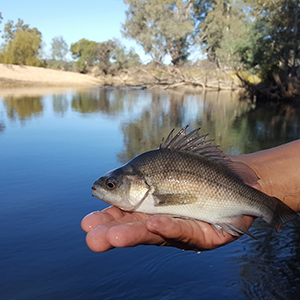Larval fish sensitivity to a simulated cold-water pulse varies between species and age

Accepted: 27 June 2022
Supplementary: 167
HTML: 135
All claims expressed in this article are solely those of the authors and do not necessarily represent those of their affiliated organizations, or those of the publisher, the editors and the reviewers. Any product that may be evaluated in this article or claim that may be made by its manufacturer is not guaranteed or endorsed by the publisher.
Authors
The release of cold-water from hypolimnetic zones of impoundments sharply reduces downstream riverine water temperature. This cold-water pollution (CWP) can extend for hundreds of kilometres, severely challenging the physiological ability of aquatic fauna, particularly ectotherms such as fish, to maintain essential processes such as metabolism, development and growth and survival. The impact of CWP on native fish, especially early life stages, is poorly known. We investigated the effect of a 24-hour exposure to a range of environmentally-related water temperatures (8, 10, 12, 14, 16, 18 and 20°C) on three age-classes (<24-hour-old, 7-day and 14-day-old larvae) of two Australian native fish species: Murray cod (Maccullochella peelii) and Macquarie perch (Macquaria australasica). Overall, larvae of M. peelii were more sensitive to lower water temperatures and hence CWP than M. australasica, indicated by higher rates of equilibrium loss. Larvae of M. peelii were most sensitive to exposure at seven days old whereas M. australasica larvae were most sensitive at <24-h-old. Using our results, we modelled pre- and post-impoundment temperature scenarios and estimated the downstream CWP footprint for both species in an Australian river reach. Larvae of M. peelii were predicted to be absent from the first 26 km of river downstream of the impoundment compared with no impact on the distribution of M. australasica. Managing riverine water temperature below impoundments is fundamental to promoting positive outcomes for endemic fish on not only a local, but global basis. This study emphasises the differential impact of CWP among the critical early life stages and fish species and highlights the urgent need to better manage hypolimnetic water releases to improve downstream river ecosystems.
Edited by
Pietro Volta, CNR-IRSA Verbania, ItalyHow to Cite

This work is licensed under a Creative Commons Attribution-NonCommercial 4.0 International License.
Similar Articles
- Xiangyu Mu, James Brower, Donald I. Siegel, Anthony J. Fiorentino II, Shuqing An, Ying Cai, Delin Xu, Hao Jiang, Using integrated multivariate statistics to assess the hydrochemistry of surface water quality, Lake Taihu basin, China , Journal of Limnology: Vol. 74 No. 2 (2015)
- Muhammed Shikhani, Chenxi Mi, Artur Gevorgyan, Gor Gevorgyan, Amalya Misakyan, Levon Azizyan, Klemens Barfus, Martin Schulze, Tom Shatwell, Karsten Rinke, Simulating thermal dynamics of the largest lake in the Caucasus region: The mountain Lake Sevan , Journal of Limnology: Vol. 81 No. s1 (2022): Lake Sevan. Past, present, and future state of a unique alpine lake
- Luigi Hinegk, Luca Adami, Sebastiano Piccolroaz, Marina Amadori, Marcello Moretti, Marco Tubino, Marco Toffolon, Multidecadal analysis of Lake Garda water balance , Journal of Limnology: Vol. 82 (2023)
- Martin Čech, Lukáš Vejřík, Jiří Peterka, Milan Říha, Milan Muška, Tomáš Jůza, Vladislav Draštík, Michal Kratochvíl, Jan Kubečka, The use of artificial spawning substrates in order to understand the factors influencing the spawning site selection, depth of egg strands deposition and hatching time of perch (Perca fluviatilis L.) , Journal of Limnology: Vol. 71 No. 1 (2012)
- Renata Tandyrak, Iwona Gołaś, Katarzyna Parszuto, Magdalena Bowszys, Daniel Szymański, Monika Harnisz, Andrzej Brudniak, Izabela Wysocka, The effect of lake restoration by the hypolimnetic withdrawal method on the intensity of ambient odour , Journal of Limnology: Vol. 75 No. 3 (2016)
- Angela Boggero, Lyudmila Kamburska, Silvia Zaupa, Marzia Ciampittiello, Michela Rogora, Tiziana Di Lorenzo, Synoptic results on the potential impacts of the Lake Maggiore water management strategy on freshwater littoral ecosystems and invertebrate biocoenosis (NW, Italy) , Journal of Limnology: Vol. 81 No. s2 (2022): Effects of water level management on lake littorals and downstream river areas
- Claire Archer, Paula Noble, David Kreamer, Vincenzo Piscopo, Marco Petitta, Michael R. Rosen, Simon R. Poulson, Gianluca Piovesan, Scott Mensing, Hydrochemical determination of source water contributions to Lake Lungo and Lake Ripasottile (central Italy) , Journal of Limnology: Vol. 76 No. 2 (2017)
- Yajun Xie, Yonghong Xie, Cong Hu, Xinsheng Chen, Feng Li, Interaction between litter quality and simulated water depth on decomposition of two emergent macrophytes , Journal of Limnology: Vol. 75 No. 1 (2016)
- Faye L. Merrix-Jones, Stephen J. Thackeray, Stephen J. Ormerod, A global analysis of zooplankton in natural and artificial fresh waters , Journal of Limnology: Vol. 72 No. 1 (2013)
- Rafael Campanelli Mortari, Raoul Henry, Horizontal distribution of Cladocera in a subtropical lake marginal to a river , Journal of Limnology: Vol. 75 No. 1 (2016)
You may also start an advanced similarity search for this article.
-
John D. Koehn, Charles R. Todd, Henry Wootton, Michael JoyMarine and Freshwater Research : 2023

 https://doi.org/10.4081/jlimnol.2022.2056
https://doi.org/10.4081/jlimnol.2022.2056





